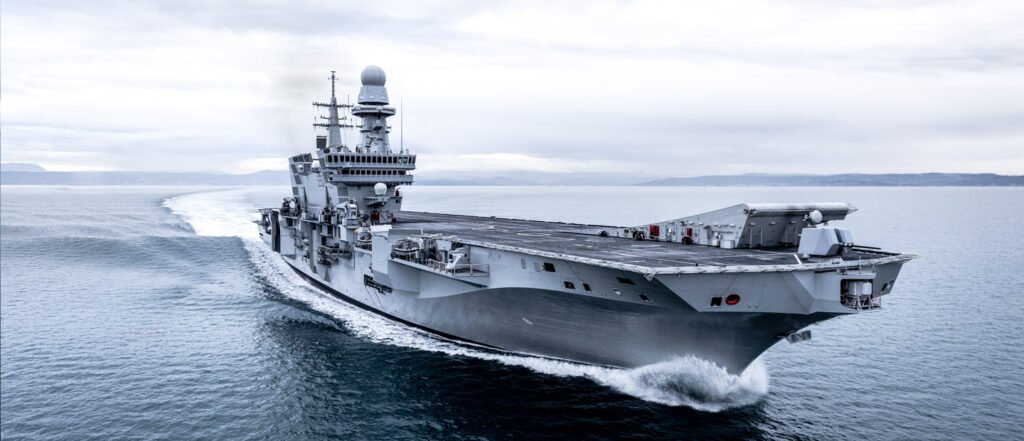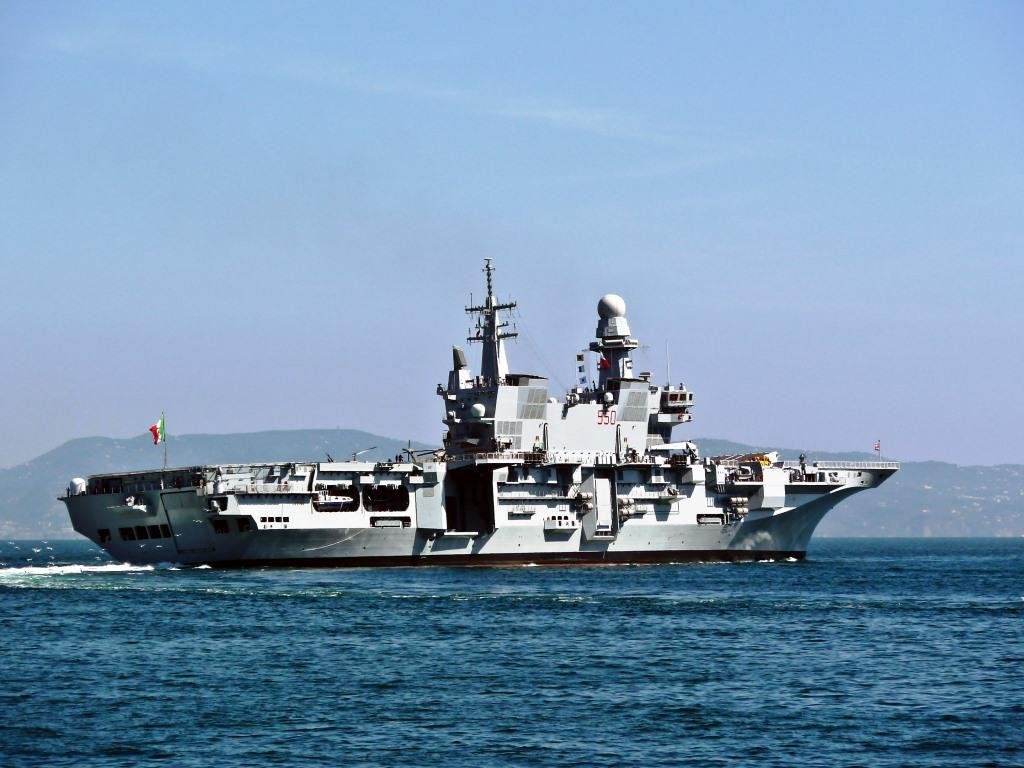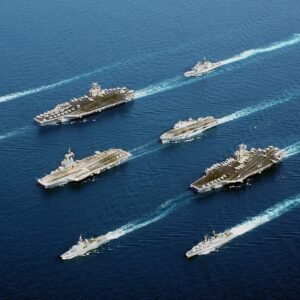The Italian Aircraft Carrier Cavour is a formidable naval vessel that serves as the flagship of the Italian Navy. Named after the renowned Italian statesman and general Camillo Benso, Count of Cavour, this aircraft carrier play a crucial role in maintaining Italy’s maritime security and projecting its military power.

1. History of the Italian Aircraft Carrier Cavour
1.1 Origins and Development
The Italian aircraft carrier Cavour, officially known as the Cavour (C 550), has a rich history that dates back to the late 1980s. The origins of the ship can be traced to Italy’s need for a modern and versatile aircraft carrier to replace the aging aircraft carrier, Giuseppe Garibaldi. The development of the Cavour was part of Italy’s naval modernization program aimed at enhancing its maritime defense capabilities.
1.2 Construction and Launch
Construction of the Cavour began in 2001 at the Fincantieri shipyard in Muggiano, La Spezia. The ship was laid down on July 17, 2001, and after several years of construction, it was launched on July 20, 2004. The launch of the Cavour marked a significant milestone in Italian naval history, as it represented the introduction of a state-of-the-art aircraft carrier with advanced capabilities.
1.3 Italian Aircraft Carrier Cavour Service and Operations
Following its launch, the Cavour underwent an extensive period of sea trials and tests to ensure its readiness for service. The ship was commissioned into the Italian Navy on March 27, 2008. Since then, the Cavour has been actively involved in various naval operations, joint exercises, and humanitarian missions, both domestically and internationally.
2. Design and Specifications of The Italian Aircraft Carrier Cavour
2.1 Dimensions and Propulsion
The Cavour has a length of 244 meters (800 feet), a beam of 39 meters (128 feet), and a displacement of approximately 27,900 tons. It is powered by a hybrid propulsion system that combines gas turbines and diesel engines, providing a maximum speed of over 29 knots (54 kilometers per hour).
2.2 Flight Deck and Hangar
The aircraft carrier features a spacious flight deck equipped with a ski-jump ramp at the bow, allowing for the launch of fixed-wing aircraft. The flight deck has an area of approximately 2,500 square meters (27,000 square feet) and can accommodate a variety of aircraft. The Cavour also has a large hangar below the flight deck, providing ample storage and maintenance facilities for its aircraft.
2.3 Italian Aircraft Carrier Cavour Weapons Systems
To ensure its self-defense and offensive capabilities, the Cavour is equipped with a range of weapons systems.
- Surface-to-Air Missile Launchers: The carrier is equipped with surface-to-air missile launchers capable of engaging airborne threats. These systems provide air defense capabilities, protecting the carrier and its accompanying assets from hostile aircraft or missiles.
- Anti-Ship Missile Systems: The Cavour is outfitted with anti-ship missile systems, which allow it to engage and neutralize surface targets, such as enemy ships or naval vessels. These systems enhance the carrier’s offensive capabilities and contribute to its role in power projection.
- Close-In Weapon Systems (CIWS): The Cavour is equipped with close-in weapon systems, such as Phalanx or Goalkeeper, which provide a final layer of defense against incoming anti-ship missiles or aircraft. These systems use rapid-firing cannons or Gatling guns to intercept and destroy threats in close proximity to the carrier.
- Decoy Systems: The carrier is likely to be equipped with decoy systems, such as chaff and flare dispensers, to confuse and divert incoming missiles or radar-guided threats. These systems help to protect the carrier by diverting enemy missiles away from the ship.
- Small Arms and Light Weapons: The Cavour may also have small arms and light weapons for onboard security and defense purposes. These weapons are typically carried by the ship’s security personnel and can include rifles, machine guns, and pistols.

2.4 The Italian Aircraft Carrier Cavour Command and Control Capabilities
The Cavour is equipped with advanced command and control systems that enable effective coordination of its operations. These systems allow for seamless integration with other naval and air assets, enhancing the carrier’s situational awareness and decision-making capabilities.
3. Aircraft and Air Wing
3.1 Fixed-Wing Aircraft
The primary fixed-wing aircraft operated from the Cavour is the F-35B Lightning II, a fifth-generation stealth fighter jet capable of vertical takeoff and landing. The Cavour can accommodate up to 16 F-35B aircraft, providing it with significant air superiority and strike capabilities.
3.2 Rotary-Wing Aircraft
The carrier also operates a variety of rotary-wing aircraft, including helicopters for anti-submarine warfare, search and rescue, and utility missions. These helicopters enhance the Cavour’s versatility and enable it to perform a wide range of operations.
3.3 Air Wing Composition and Capabilities
The Cavour’s air wing is composed of a mix of fixed-wing and rotary-wing aircraft, allowing for a flexible and comprehensive operational capability. With its complement of F-35B aircraft, helicopters, and support aircraft, the Cavour can conduct a wide range of missions, including strike operations, air superiority, anti-submarine warfare, and search and rescue missions.
4. Versatility and Role
4.1 Amphibious Operations
The Cavour is specifically designed to support amphibious operations, allowing for the deployment of ground forces, equipment, and supplies. The ship’s spacious hangar and flight deck enable the embarkation and launch of helicopters and landing craft, enhancing Italy’s amphibious assault capabilities.
4.2 Power Projection of The Italian Aircraft Carrier Cavour
As an aircraft carrier, the Cavour serves as a powerful instrument of power projection. It allows Italy to project its military capabilities beyond its shores, enhancing its ability to deter potential adversaries and protect national interests.
4.3 Humanitarian and Peacekeeping Missions
In addition to its military roles, the Cavour has also been involved in numerous humanitarian and peacekeeping missions. The ship’s versatility and airlift capabilities enable it to provide aid, disaster relief, and support to regions affected by natural disasters or conflicts, showcasing Italy’s commitment to global stability and cooperation.
5. Italian Aircraft Carrier Cavour Operational Capabilities

5.1 Strike and Air Superiority Operations
Equipped with the advanced F-35B aircraft, the Cavour is capable of conducting precision strike operations against land and sea targets. Its air wing also provides formidable air superiority capabilities, ensuring air dominance in contested environments.
5.2 Anti-Submarine Warfare (ASW)
With its complement of anti-submarine warfare helicopters and advanced sonar systems, the Cavour enhances Italy’s ability to detect and neutralize submarine threats. It plays a crucial role in protecting maritime assets and ensuring the safety of Italian and allied naval forces.
5.3 Search and Rescue (SAR)
The Cavour’s rotary-wing aircraft and extensive search and rescue capabilities enable it to respond quickly and effectively to distress calls at sea. It plays a vital role in saving lives and providing humanitarian assistance in maritime environments.
5.4 Command and Control Functions
The Cavour serves as a mobile command and control center, capable of coordinating complex naval and air operations. Its advanced communication systems and extensive situational awareness capabilities ensure effective command and control functions in diverse operational scenarios.
6. International Cooperation and Collaboration
6.1 Joint Operations with NATO Allies
The Cavour frequently participates in joint operations and exercises with NATO allies, enhancing interoperability and cooperation among partner nations. These collaborative efforts contribute to collective defense and regional stability.
6.2 Exercises and Deployments
The aircraft carrier also undertakes bilateral and multinational exercises with partner navies, showcasing Italy’s commitment to maintaining strong maritime partnerships. Furthermore, the Cavour’s deployments to various regions demonstrate Italy’s global presence and its role as a responsible maritime actor.
7. Modernization and Upgrades in The Italian Aircraft Carrier Cavour
7.1 Mid-Life Refurbishment
To ensure its continued effectiveness and operational readiness, the Cavour is scheduled to undergo a mid-life refurbishment program. This program includes upgrades to its propulsion systems, sensors, and weapons systems, keeping the carrier technologically advanced and capable of meeting future challenges.
7.2 F-35B Integration
The integration of the F-35B aircraft into Cavour’s air wing represents a significant modernization effort. This integration enhances the carrier’s strike capabilities, providing Italy with a cutting-edge platform for air operations.
7.3 Future Enhancements

In the future, the Cavour may undergo further enhancements and upgrades to incorporate emerging technologies and operational requirements. These enhancements will ensure that the aircraft carrier remains at the forefront of naval capabilities and contributes to Italy’s maritime defense strategy.
8. Contribution to Italian Naval Power
8.1 Strengthening Italy’s Maritime Defense
The Cavour significantly strengthens Italy’s maritime defense capabilities, allowing it to project power, protect national interests, and safeguard vital sea lanes. The carrier’s advanced systems and aircraft contribute to Italy’s overall naval strength and deterrence posture.
8.2 Enhanced National Security
By operating a modern aircraft carrier like the Cavour, Italy enhances its national security and defense readiness. The carrier’s capabilities provide Italy with a strategic advantage, allowing it to respond effectively to regional and global security challenges.
8.3 Promoting Global Stability
The Cavour’s participation in humanitarian missions, peacekeeping efforts, and international collaborations demonstrates Italy’s commitment to promoting global stability. The carrier serves as a platform for international cooperation, showcasing Italy’s willingness to contribute to humanitarian relief and peacekeeping operations worldwide.
9. Notable Italian Aircraft Carrier Cavour Operations and Missions
9.1 Operation Unified Protector (Libya)
The Cavour played a significant role in Operation Unified Protector, a NATO-led military intervention in Libya in 2011. The carrier’s aircraft conducted air strikes against targets in support of the mission’s objectives, contributing to the enforcement of a no-fly zone and the protection of civilian populations.
9.2 Joint Exercises and Task Force Deployments
The Cavour has participated in numerous joint exercises with allied navies, including multinational task force deployments. These exercises and deployments enhance interoperability, strengthen alliances, and promote shared maritime security objectives.
9.3 Humanitarian Relief Efforts
The Cavour has been deployed to regions affected by natural disasters, providing critical humanitarian relief and assistance. It has delivered supplies, evacuated civilians, and supported recovery efforts, highlighting the ship’s versatility. Its role as a humanitarian asset.
Read More Aircraft Carriers:- CV 16 Liaoning: The Chinese Aircraft Carrier and Russian Admiral Kuznetsov Aircraft Carrier.







